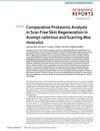Generating Disulfides in Multicellular Organisms: Emerging Roles for a New Flavoprotein Family
March 2007
in “
Journal of Biological Chemistry
”
TLDR QSOX enzymes help form protein bonds in cells, especially in tissues with high secretory activity.
The document reviewed the role of disulfide bonds in protein structure and stability, focusing on the emerging roles of flavoproteins, particularly the QSOX family of sulfhydryl oxidases, in multicellular organisms. It highlighted the importance of protein disulfide isomerases (PDIs) and their cooperation with other components in the endoplasmic reticulum's quality control system. QSOX enzymes, abundant in tissues with high secretory activity like hair follicles, were noted for their ability to oxidize a wide range of reduced proteins without relying on PDIs for electron transfer. The study emphasized the catalytic advantage provided by the fusion of thioredoxin and Erv/ALR domains in QSOX and suggested a unique mechanism of action due to their presence in the endoplasmic reticulum despite lacking conventional retention sequences. While significant progress was made in understanding these processes, the precise roles of PDIs and the mechanisms of flavoproteins in oxidative folding remained unresolved.


![Integrating Multi-Omics Analyses of Nonomuraea Dietziae to Reveal the Role of Soybean Oil in [(4′-OH)MeLeu]4-CsA Overproduction](/images/research/0eba9759-3aa4-4a06-a70a-2d9c46be53f3/small/23018.jpg)
